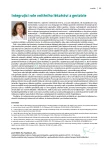Anticoagulant therapy in the elderly
Authors:
Debora Karetová 1; Jan Bultas 2
Authors‘ workplace:
II. interní klinika – klinika kardiologie a angiologie 1. LF UK a VFN v Praze
1; Farmakologický ústav 3. LF UK, Praha
2
Published in:
Vnitř Lék 2018; 64(11): 1011-1020
Category:
Overview
Elderly and fragile patients have a higher risk of atrial fibrillation, a higher risk of systemic embolism. They are therefore often candidates for long-term anticoagulation medication. At the same time, they have an increased risk of bleeding due to age and co-morbidities, which anticoagulation therapy necessarily potentiates. New Oral Direct Anticoagulants (NOAC) registered in the Czech Republic – dabigatran, rivaroxaban, apixaban or edoxaban – are a good alternative to the currently dominant warfarin in many of these indications. Their great advantage is that they do not need to be regularly monitored on a laboratory basis and are considered to be safer, especially to significant reduction of the risk of intracranial haemorrhage. Each drug in the group of direct oral anticoagulants has some specificity resulting from pharmacological properties or the results of registration studies, so it is possible to individually determine an optimal anticoagulation strategy. Older, respectively fragile patients are characterized by reduced body weight, limited renal function, and multiple comorbidities (associated with many co-medications). For a number of seniors, it is advantageous to use a reduced dose of these drugs. Consideration of benefit and risk is often complicated in elderly patients, but this should be repeatedly done during the therapy.
Key words:
anticoagulation therapy – apixaban – dabigatran – edoxaban – fragile patient – geriatrics – rivaroxaban
Sources
- Mant J, Hobbs FD, Fletcher K et al. [BAFTA investigators; Midland Research Practices Network (MidReC)]. Warfarin versus aspirin for stroke prevention in an elderly community population with atrial fibrillation (the Birmingham Atrial Fibrillation Treatment of the Aged Study, BAFTA): a randomised controlled trial. Lancet 2007; 370(9586): 493–503. Dostupné z DOI: <http://dx.doi.org/10.1016/S0140–6736(07)61233–1>.
- Banerjee A, Fauchier L, Bernard-Brunet A et al. Composite risk scores and composite endpoints in the risk prediction of outcomes in anticoagulated patients with atrial fibrillation. The Loire Valley Atrial Fibrillation Project. Thromb Haemost 2014; 111(3): 549–556. Dostupné z DOI: <http://dx.doi.org/10.1160/TH13–12–1033>.
- Senoo K, Proietti M, Lane DA et al. Evaluation of the HAS-BLED, ATRIA, and ORBIT Bleeding Risk Scores in Patients with Atrial Fibrillation Taking Warfarin. Am J Med 2016; 129(6): 600–607. Dostupné z DOI: <http://dx.doi.org/10.1016/j.amjmed.2015.10.001>.
- Lip GYH, Clementy N, Pericart L et al. Stroke and Major Bleeding Risk in Elderly Patients Aged ≥75 Years With Atrial Fibrillation. Stroke 2015; 46(1): 143–150. Dostupné z DOI: <http://dx.doi.org/10.1161/STROKEAHA.114.007199>.
- Eikelboom JW, Wallentin L, Connolly SJ et al. Risk of bleeding with 2 doses of dabigatran compared with warfarin in older and younger patients with atrial fibrillation: an analysis of the randomized evaluation of long-term anticoagulant therapy (RE-LY) trial. Circulation 2011; 123(21): 2363–2372. Dostupné z DOI: <http://dx.doi.org/10.1161/CIRCULATIONAHA.110.004747>.
- Halperin JL, Hankey GJ, Wojdyla DM et al. Efficacy and safety of rivaroxaban compared with warfarin among elderly patients with nonvalvular atrial fibrillation in the Rivaroxaban Once Daily, Oral, Direct Factor Xa Inhibition Compared With Vitamin K Antagonism for Prevention of Stroke and Embolism Trial in Atrial Fibrillation (ROCKET AF). Circulation. 2014; 130(2):138–146. Dostupné z DOI: < http://doi 10.1161/CIRCULATIONAHA.113.005008>.
- Halvorsen S, Wallentin L, Yang H et al. Efficacy and safety of apixaban compared with warfarin according to age for stroke prevention in atrial fibrillation. J Am Coll Cardiol 2013; 61(10 Suppl): E315.
- Legrand M, Mateo J, Aribaud A et al. The use of dabigatran in elderly patients. Arch Intern Med 2011; 171(14): 1285–1286. Dostupné z DOI: <http://dx.doi.org/10.1001/archinternmed.2011.314>.
- Kato ET, Giugliano RP, Ruff CT et al. Efficacy and Safety of Edoxaban in Elderly Patients With Atrial Fibrillation in the ENGAGE AF-TIMI 48 Trial. J Am Heart Assoc 2016; 5(5). pii: e003432. Dostupné z DOI: <http://dx.doi.org/10.1161/JAHA.116.003432>.
- Okumura K, Lip GYH, Akao M et al. Edoxaban for the management of elderly Japanese patients with atrial fibrillation ineligible for standard oral anticoagulant therapies: Rationale and design of the ELDERCARE-AF study. Am Heart J 2017; 194: 99–106. Dostupné z DOI: <http://dx.doi.org/10.1016/j.ahj.2017.08.017>.
- Sjoegren V, Bystroem B, Renlund H et al. Non-vitamin K oral anticoagulants are non-inferior for stroke prevention but cause fewer major bleedings than well-managed warfarin: A retrospective register study. PLoS ONE 12(7): e0181000. Dostupné z DOI: <https://doi.org/10.1371/journal>.
- Stein PD, Hull RD, Kayali F et al. Venous thromboembolism according to age: the impact of an aging population. Arch Intern Med 2004; 164(20): 2260–2265. Dostupné z DOI: <http://dx.doi.org/10.1001/archinte.164.20.2260>.
- Prandoni P, Trujillo-Santos J, Sanchez-Cantalejo E et al. Major bleeding as a predictor of mortality in patients with venous thromboembolism: findings from the RIETE Registry. J Thromb Haemost 2010; 8(11): 2575–2577. Dostupné z DOI: <http://dx.doi.org/10.1111/j.1538–7836.2010.04039.x>.
- Geldhof V, Vandenbriele C, Verhamme P et al. Venous thrombembolism in the elderly: efficacy and safety of non-VKA oral anticoagulants. Thromb 2014; 12: 21. Dostupné z DOI: <http://dx.doi.org/10.1186/1477–9560–12–21>.
- Ruff CT, Giugliano RP, Braunwald E et al. Comparison of the efficacy and safety of new oral anticoagulants with warfarin in patients with atrial fibrillation: a meta-analysis of randomised trials. Lancet 2014; 383(9921): 955–962. Dostupné z DOI: <http://dx.doi.org/10.1016/S0140–6736(13)62343–0>.
- Agnelli G, Buller HR, Cohen A et al. Apixaban for extended treatment of venous thromboembolism. N Engl J Med 2013; 368(8): 699–708. Dostupné z DOI: <http://dx.doi.org/10.1056/NEJMoa1207541>.
- Forbes HL, Polasek TM. Potential drug–drug interactions with direct oral anticoagulants in elderly hospitalized patients. Ther Adv Drug Saf 2017; 8(10): 319–328. Dostupné z DOI: <http://dx.doi.org/10.1177/2042098617719815>.
- Kearon C, Akl EA, Ornelas J et al. Antithrombotic Therapy for VTE Disease: CHEST Guideline and Expert Panel Report. Chest 2016; 149(2): 315–352. Dostupné z DOI: <http://doi: 10.1016/j.chest.2015.11.026>.
Labels
Diabetology Endocrinology Internal medicineArticle was published in
Internal Medicine

2018 Issue 11
Most read in this issue
- Thermoregulatory disorders and their significance in the elderly
- Sarcopenia as a severe organ failure, its diagnosing and present therapeutic possibilities
- Electrolyte and water disorders in old age
- Falls: a significant cause of morbidity and mortality in elderly people
